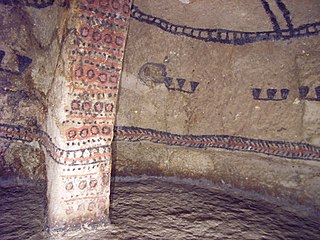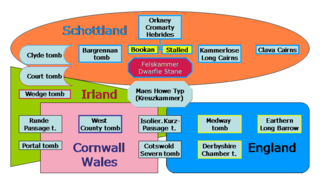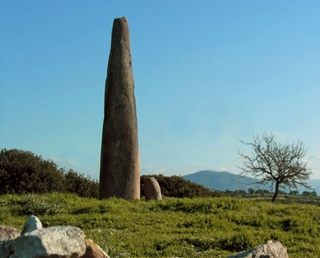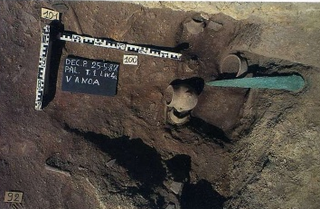Related Research Articles

Neolithic architecture refers to structures encompassing housing and shelter from approximately 10,000 to 2,000 BC, the Neolithic period. In southwest Asia, Neolithic cultures appear soon after 10,000 BC, initially in the Levant and from there into the east and west. Early Neolithic structures and buildings can be found in southeast Anatolia, Syria, and Iraq by 8,000 BC with agriculture societies first appearing in southeast Europe by 6,500 BC, and central Europe by ca. 5,500 BC (of which the earliest cultural complexes include the Starčevo-Koros, Linearbandkeramic, and Vinča.

The Bell Beaker culture, also known as the Bell Beaker complex or Bell Beaker phenomenon, is an archaeological culture named after the inverted-bell beaker drinking vessel used at the very beginning of the European Bronze Age, arising from around 2800 BC. Bell Beaker culture lasted in Britain from c. 2450 BC, with the appearance of single inhumation graves, until as late as 1800 BC, but in continental Europe only until 2300 BC, when it was succeeded by the Unetice culture. The culture was widely dispersed throughout Western Europe, being present in many regions of Iberia and stretching eastward to the Danubian plains, and northward to the islands of Great Britain and Ireland, and was also present in the islands of Sardinia and Sicily and some small coastal areas in north-western Africa. The Bell Beaker phenomenon shows substantial regional variation, and a study from 2018 found that it was associated with genetically diverse populations.

Domus de Janas are a type of pre-Nuragic rock-cut chamber tomb found in Sardinia. They consist of several chambers quarried out by the people of the San Ciriaco through Ozieri cultures and subsequent cultures, resembling houses in their layout.
The Castro of Vila Nova de São Pedro is a Chalcolithic archaeological site in the civil parish of Vila Nova de São Pedro, municipality of Azambuja, in the Portuguese Estremadura area of Lezíria do Tejo. It is important for the discovery of thousands of arrowheads within its fortified settlement, associated with the Chalcolithic period of human settlement. associated with the long-lived fortified town, or castro, of Zambujal, near the municipality of Torres Vedras. The period of "urban" settlement lasted from 2600 to 1300 BCE, and was a contemporary of the southeastern Spanish settlements of Los Millares and El Argar.

The Hypogeum of Ħal Saflieni is a Neolithic subterranean structure dating to the Saflieni phase in Maltese prehistory, located in Paola, Malta. It is often simply referred to as the Hypogeum, literally meaning "underground" in Greek. The Hypogeum is thought to have been a sanctuary and necropolis, with the estimated remains of more than 7,000 people documented by archeologists, and is among the best preserved examples of the Maltese temple building culture that also produced the Megalithic Temples and Xagħra Stone Circle.

The Xagħra Stone Circle, also known as the Xagħra Hypogeum or the Brochtorff Circle, is a Neolithic funerary complex located in Xagħra, Gozo, Malta. It consists of a series of caves which were used to bury the dead, and which were surrounded by a walled enclosure. It mainly dates back to around 3000 to 2400 BC, although the earliest tombs at the site date back to 4100 to 3800 BC. The caves collapsed sometime before 2000 BC, and the site was later used for domestic and agricultural purposes.

A hypogeum or hypogaeum is an underground temple or tomb.

The dolmens of Jersey are neolithic sites, including dolmens, in Jersey. They range over a wide period, from around 4800 BC to 2250 BC, these dates covering the periods roughly designated as Neolithic, or “new stone age”, to Chalcolithic, or “copper age”.

Prehistory in the Iberian peninsula begins with the arrival of the first Homo genus representatives from Africa, which may range from c. 1.5 million years (Ma) ago to c. 1.25 Ma ago, depending on the dating technique employed, so it is set at c. 1.3 Ma ago for convenience. The end of Iberian prehistory coincides with the first entrance of the Roman army into the peninsula, in 218 before Christ (BC), which led to the progressive dissolution of pre-Roman peoples in Roman culture. This end date is also conventional, since pre-Roman writing systems can be traced to as early as 5th century BC.

Tierra abajo is one of the ancient Pre-Columbian cultures of Colombia. It started to flourish around 200 BC in the mountains of southwest Colombia, and continued into the 17th century. The Tierradentro culture is particularly well known for its dense collection of elaborate pre-Columbian hypogea.

Bronze Age Britain is an era of British history that spanned from c. 2500–2000 BC until c. 800 BC. Lasting for approximately 1,700 years, it was preceded by the era of Neolithic Britain and was in turn followed by the period of Iron Age Britain. Being categorised as the Bronze Age, it was marked by the use of copper and then bronze by the prehistoric Britons, who used such metals to fashion tools. Great Britain in the Bronze Age also saw the widespread adoption of agriculture.
The Wartberg culture, sometimes: Wartberg group (Wartberggruppe) or Collared bottle culture (Kragenflaschenkultur) is a prehistoric culture from 3,600 -2,800 BC of the later Central European Neolithic. It is named after its type site, the Wartberg, a hill near Niedenstein-Kirchberg in northern Hesse, Germany.

The Tomb of the Scipios, also called the hypogaeum Scipionum, was the common tomb of the patrician Scipio family during the Roman Republic for interments between the early 3rd century BC and the early 1st century AD. Then it was abandoned and within a few hundred years its location was lost.

The Bonnanaro culture is a protohistoric culture that flourished in Sardinia during the 2nd millennium BC, considered to be the first stage of the Nuragic civilization. It takes its name from the comune of Bonnanaro in the province of Sassari where in 1889 the eponymous site was discovered.

The Neolithic period in the British Isles lasted from c. 4000 to c. 2,500 BCE. Constituting the final stage of the Stone Age in the region, it was preceded by the Mesolithic and followed by the Bronze Age.

British megalith architecture is the study of those ancient cultures that built megalithic sites on the British Isles, including the research and documentation of these sites. The classification sometimes used of these cultures based on geological criteria is problematic.

The Arzachena culture was a pre-Nuragic culture of the Late Neolithic Age occupying Gallura and part of southern Corsica from approximately the 4th to the 3rd millennium BC. It takes its name from the Sardinian town of Arzachena.

The Pre-Nuragic period refers to the prehistory of Sardinia from the Paleolithic until the middle Bronze Age, when the Nuragic civilization flourished on the island.

The Beaker culture in Sardinia appeared circa 2100 BC during the last phase of the Chalcolithic period. It initially coexisted with and then replaced the previous Monte Claro culture in Sardinia, developing until the ancient Bronze Age circa 1900–1800 BC. Then, the Beaker culture mixed with the related Bonnanaro culture, considered the first stage of the Nuragic civilization.

The Hypogeum of Sant'Iroxi is an archaeological site located near the town of Decimoputzu in the province of South Sardinia.
References
- ↑ Germanà 1995, p. 102.
- ↑ Germanà 1995, p. 103.